Interior Decoration Trends:
Making and Re-Making
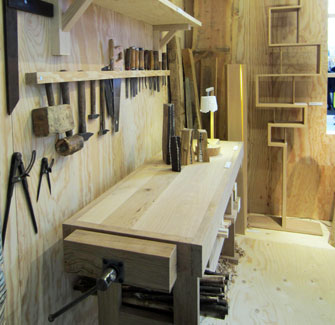
“Workshop Secrets,” a display at Maison&Objet. Photo: Colin Eaton
The theme for the January 2015 Maison&Objet trade show, held twice a year just outside Paris to showcase innovations in home accessories and furnishings, was “make.”
Among the trends that emerged at the fair were handcrafted objects, old products recycled into new and the use of waste or byproducts to create new objects. This movement, perhaps a reaction to mass overconsumption, reflects a desire to create and to know more about product origins and design processes.
The latter trend was illustrated in “Workshop Secrets,” a series of pavilions designed and curated by trend forecaster Elizabeth Leriche that highlighted the relationship designers and artisans have with their workspace, tools and materials. Visitors were invited into woodwork, metalwork, glass and ceramics ateliers, where the senses were stimulated through touch, vision, smell and the work of artists displayed amid their tools and raw materials.
Another trend was “Nature-made,” or “the wonder of the artyculturist,” as François Bernard put it in the exhibition of work by creators, artists and designers he curated. It focused on a major research and design trend that sets up the conditions needed to develop a project and then lets nature run its course to produce an object.
The increasing use of color has been a noticeable trend over the past few shows. Perhaps the global recession, coupled with a rejection of minimalism, has awakened interest not just in the artisanal but also in texture and color. There is a renewed vibrancy – a sense of optimism perhaps. Objects for the home seem to be regaining their soul, with revived interest in the provenance of raw materials and the process of creation. All good in my book!
Here are some of the highlights of a visit to the nine inspiration-filled halls:
Duwel, a French company based in Montaurnaux, is owned by Fredéric Goutorbe, who makes handcrafted footstools, cushions
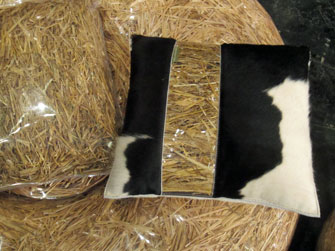
Hay is for horses, or for home furnishings. Photo: Colin Eaton
and even Christmas decorations from biodegradable plastic stuffed with straw in the spirit of what he calls “slow design.”
In a similar vein, the Italian company Crizu creates unique design objects by hand-folding the pages of old, obsolete books one by one. It
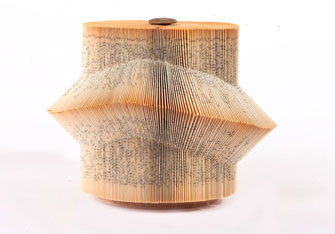
“Wave,” a folded-paper sculpture by Crizu.
also makes a small line of paper jewelry.
Canadian design studio Molo, led by architects Stephanie Forsythe and Todd MacAllen, uses paper on a larger scale. Their room dividers,
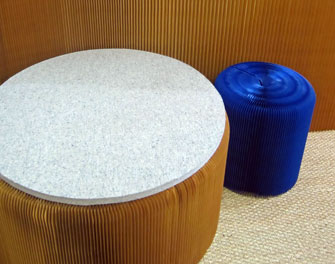
Stools and room divider made of paper by Molo. Photo: Colin Eaton
stools and lights have won international awards and are featured in many design collections, including that of MoMA.
Jonathan Adler is always a favorite. His pieces, ranging from trinkets to vases, cushions, lighting, furniture, and pottery and
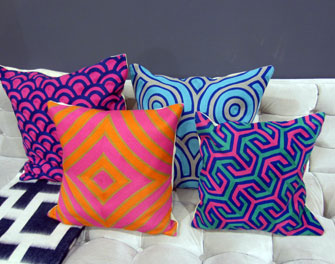
Pillows by Jonathan Adler. Photo: Colin Eaton
ceramics, inspire a feeling of joy, “by creating a foundation of timelessly chic furniture and accessorizing with abandon,” as his website puts it. This charismatic New York-based designer started out as a potter, and his career took off from there
Ici et Là, based in Barcelona, combines old
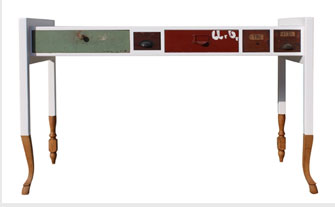
Writing desk from Ici et Là’s “Rescue Collection.”
furniture components like drawers and doors with new pieces to create one-of-a-kind furniture made by French and Spanish designers.
The diversity of objects on show at Maison&Objet is always amazing. During this visit to the fair, I came across a fascinating stand showcasing basic
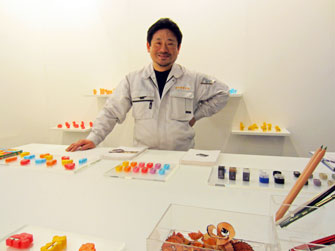
Nakajima Jukyudo’s low-tech, high-quality pencil sharpeners. Photo: Colin Eaton
manual pencil sharpeners. Nakajima Jukyudo, founded in 1933 in Osaka, has been manufacturing pencil sharpeners for three generations. If you see “NJK Japan” stamped on the blade of your sharpener, you’ll know it’s as “sharp as a Samurai sword,” as the company claims.
Reader reaction: Click here to respond to this article (your response may be published on this page and is subject to editing).
Please support Paris Update by ordering books from Paris Update’s Amazon store at no extra cost. Click on your preferred Amazon location: U.K., France, U.S.
More reviews of Paris art shows.
© 2015 Paris Update
Favorite